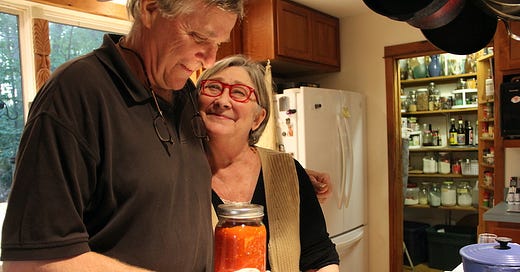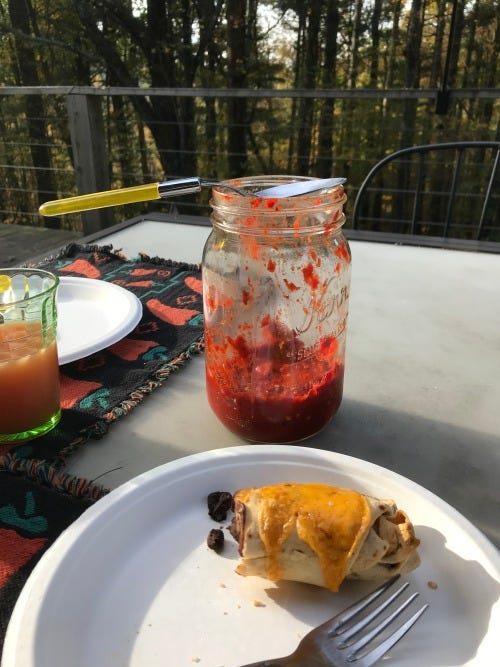At a friend’s milestone birthday party a few weeks ago, the supper spread was what we’ve come to expect from the inveterate party-givers L.A. and Trip Renn. These two Georgia-born gourmands are always ready to party at their handsome house in the woods outside Carrboro, no matter the occasion. Case-in-point: They host an oyster roast every December that involves bushels of fresh North Carolina bivalves slowly pried open by intense heat and wild spirals of fragrant hickory smoke. Once shucked, the oysters are decorated with generous shakes of Trip’s coveted Orange County Red–a quasi-mignonette sauce that’s been heavily influenced by his love of New Orleans cuisine. A mix tape of the same flavors—Zydeco, Jazz, Blues, and Allman-era rock–always accompanies these comestibles.
For the October birthday, the dining table was covered with picnic food—two-bite ham, havarti, and cranberry sandwiches; dumplings, both steamed and fried; smoked bluefish that Trip had caught at the coast a few days before; bubbly artichoke and cheese dip with baguette slices; and an ample plate of deviled eggs. Sighting the latter, I did a double take. Stuffed in the hard-boiled whites, the yoke mixture had a pinkish cast. I snatched one immediately and took a bite and found the unmistakable flavor of wood smoke and fiery peppers amid the pickle and mayo. A happy surprise.
“It’s Trip’s adobo,” L.A. said, catching me examining the half eaten half. She then walked me toward the fridge. There, on a shelf at eye level, a quart jar glowed a brilliant red among random bottles of Modelo, Dos Equis, and other cooling quaffs. The adobo was thickish, dappled with white seeds, and not much liquid evident. “I put it in cornbread, pimiento cheese, soups, and mix it with sour cream for a dip,” L.A. said, shaking and shimmying at the delightful thought of these dishes. (L.A. wears spectacles that match the color of the adobo.)
Trip and L.A. with the stuff
As I soon learned, the peppers in this recipe were a variety of jalapenos that easily ripen to a bold red and have a very meaty interior, plump with sweetness, and variable by crop in degree of heat. “I started growing them in the garden because the deer don’t like them, they tolerate drought, and they’re prolific,” Trip told me later, “but this year’s crop was not so good. I need to make some more.”
We jumped right on it. Donna and I went to the Carrboro Farmers Market and bought a couple sacks of Concho Jalapenos from Mike Perry of Periwinkle Farm in northern Chatham County. Mike, a talented brick mason, worked with Trip in the construction business years ago, and he grinned when we told him of our mission.
According to The Oxford Companion to Food, adobo “is a culinary term of the Phillipines which usually refers to pork, or chicken and pork, stewed with vinegar, bay leaf, peppercorns, garlic, and soy sauce until brown and aromatic." But the word adobo is actually Spanish, and you are likely to find something called adobo in any Mexican tienda–a mixture of ground chiles, spices and herbs that are made into a paste by adding vinegar and/or oil. It’s used as a meat marinade. On a Mexican restaurant’s menu, you may also find a dish called adobo–usually pork–that has been flavored with this paste. So adobo is both a marinade and a dish made with the marinade.
Black bean burrito waiting for adobo Photo by Donna Campbell
In Trip Renn’s lexicon, however, adobo is something to add to any dish "when you want a little spice."
He can’t remember where he got the idea to use fresh peppers (instead of dried chiles) to make his adobo, and of course, smoke-dried jalapenos are called chipotle peppers, so Trip’s concoction is sort of a chipotle adobo, but the chiles in this recipe are not allowed to dry out. Trip stops short of evaporating all the juices in the smoking process, and then he chops the still moist peppers in a blender, adding apple cider vinegar. Trip is convinced the vinegar makes this condiment safe for consumption for a number of weeks in the fridge. "It’s pretty bug proof,” he says. The finished product, incidentally, looks more like relish than paste.
We gathered one weekday afternoon in Trip’s woodworking shop. He pulled out a well-used barrel smoker. As we began, he asked me if I thought the lid still smelled of the blue fish he’d smoked a week before. I stuck my nose in and shook my head. Satisfied, Trip loaded the firebox with a scrap of oak flooring, some dried prunings from his apple trees, and a few shavings of well-seasoned western red cedar to serve as starter. The cedar he said, would burn up quickly and not flavor the peppers.
Once the apple twigs caught fire, Trip threw in some brick-sized pieces of hickory, also harvested from the nearby woods. He noted that a friend had recently tried smoking something with persimmon wood to poor effect. He prefers apple. A pan of water was suspended above the firebox, and the peppers were laid out on the third tier, just under the lid. Unlike when smoking meat, no temperature monitoring was necessary. Trip did issue one word of caution, however. Even if the smoke makes you want to, don’t rub your eyes after you’ve handled the fresh peppers!
The beauty of Trip’s adobo is that everyone can add a touch to a meal in proportion to their personal tolerance for heat and smoke. A teaspoon or so of this batch, made with Mike Perry’s peppers, went a long way in terms of the burn. In a couple weeks’ time, we’ve consumed many a spoonful with breakfast, lunch, and dinner. Added to grits, the adobo made me feel like I was sitting by an early morning campfire instead of my dining room table. Washed down with delicious coffee, it added a little happy dynamite to the day.
Thanks to Donna Campbell for this joyfully edited video of Trip’s process, and thanks to Trip and L.A. Renn, who could have their own food show.






